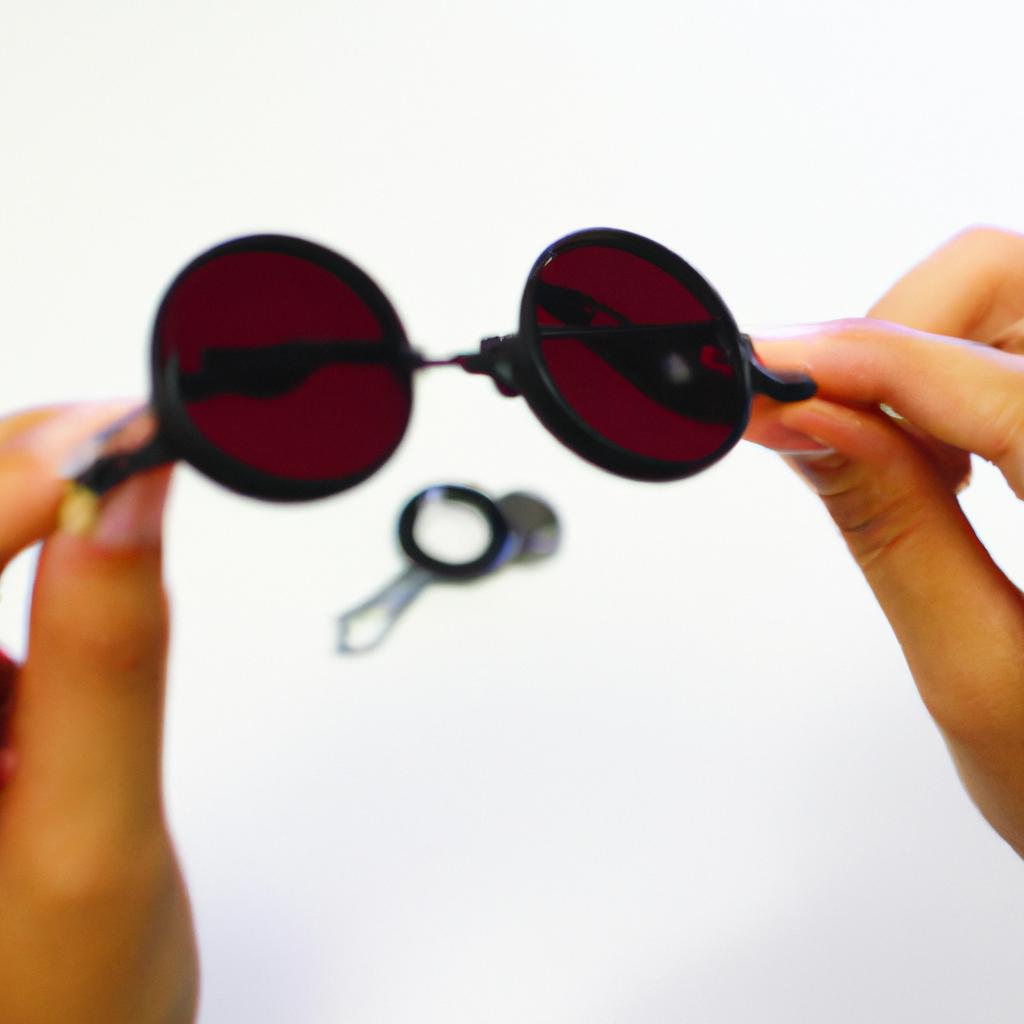Lens Materials for Sunglasses: A Comprehensive Guide

From the scorching sun rays to harmful ultraviolet (UV) radiation, sunglasses have become an essential accessory for protecting our eyes. However, not all sunglasses are created equal, and their effectiveness in shielding our eyes depends largely on the type of lens materials used. In this comprehensive guide, we will delve into the various lens materials commonly found in sunglasses and explore their unique properties and benefits.
Imagine a scenario where two individuals purchase sunglasses from different brands but with similar designs. One person experiences discomfort while wearing them under intense sunlight, whereas the other enjoys optimal vision clarity and comfort. The key difference lies in the choice of lens material used by each brand. Lens materials play a crucial role in determining factors such as durability, optical quality, weight, and resistance to scratches or impacts. Understanding these different lens materials can empower consumers to make informed decisions when selecting sunglasses that best suit their needs.
In this article, we aim to provide readers with an extensive understanding of various lens materials available in sunglasses today. By exploring the characteristics of popular options like glass lenses, polycarbonate lenses, and CR-39 lenses, readers will gain insights into the advantages and disadvantages associated with each material type. Additionally, we will discuss specialized lens coatings that further enhance visual performance and protect the eyes from harmful glare and UV radiation.
Glass lenses are known for their exceptional optical clarity. They offer superior scratch resistance and do not distort colors, making them an excellent choice for individuals who prioritize visual acuity. However, glass lenses tend to be heavier than other materials, which can cause discomfort when worn for extended periods. Additionally, they are more prone to shattering upon impact, making them less ideal for sports or activities that involve a higher risk of accidents.
Polycarbonate lenses are highly durable and impact resistant. They are significantly lighter than glass lenses, providing increased comfort during wear. Polycarbonate lenses also offer built-in UV protection without the need for additional coatings. Their impact resistance makes them suitable for outdoor activities like biking or skiing. However, one drawback of polycarbonate lenses is that they may have slightly lower optical clarity compared to glass lenses.
CR-39 lenses (also known as plastic lenses) strike a balance between affordability and optical performance. They are lightweight and provide good optical quality while offering better impact resistance than glass lenses. CR-39 lenses are more susceptible to scratches compared to glass or polycarbonate options, so it’s important to handle them with care. Despite this drawback, they remain a popular choice due to their affordability and wide range of available lens treatments.
Specialized lens coatings can further enhance the performance of sunglasses. Anti-reflective coatings reduce glare by minimizing light reflections off the front and back surfaces of the lens, resulting in improved visual clarity, especially in bright conditions or when looking at screens. Polarized coatings filter out horizontal light waves that create glare from reflective surfaces such as water or snow, enhancing visibility and reducing eye strain.
In summary, selecting the right lens material for sunglasses involves considering factors such as optical clarity, durability, weight, and resistance to scratches or impacts. Glass lenses provide exceptional visual acuity but are heavier and more prone to shattering upon impact. Polycarbonate lenses offer excellent impact resistance and lightweight comfort but may have slightly lower optical clarity. CR-39 lenses strike a balance between affordability and performance but are more susceptible to scratches. Specialized lens coatings like anti-reflective coatings and polarized coatings can further enhance visual performance and protect the eyes from glare and UV radiation.
Different Types of Lens Materials for Sunglasses
Imagine you are going on a beach vacation and have just bought a new pair of sunglasses. As you stroll along the shoreline, soaking up the sun’s rays, you notice that your vision seems distorted and hazy. Frustrated by this experience, you wonder if it could be due to the lens material in your sunglasses. The choice of lens materials plays a crucial role in determining the clarity, weight, durability, and even cost of sunglasses.
To begin with, let us explore some common types of lens materials used in sunglasses. Polycarbonate lenses are widely popular due to their impact resistance and lightweight nature. They provide excellent protection against harmful UV radiation and are often used in sports eyewear where durability is essential. Another frequently chosen option is CR-39 plastic lenses which offer good optical quality at an affordable price point. These lenses can easily accommodate prescription requirements as well.
When considering lens materials for sunglasses, it is important to evaluate their pros and cons before making a decision. To help you understand better, here is a bullet point list highlighting key aspects:
- Lightweight: Some lens materials such as polycarbonate are significantly lighter than others like glass.
- Impact Resistance: Certain lens materials like polycarbonate offer exceptional resistance against impacts or accidental drops.
- Optical Clarity: Different materials vary in terms of optical clarity; high-quality plastics may come close to matching glass lenses but might not achieve similar results.
- Cost: The price range varies across different lens materials, with options available to suit various budgets.
| Lens Material | Weight | Impact Resistance | Optical Clarity |
|---|---|---|---|
| Polycarbonate | Light | Excellent | Good |
| CR-39 Plastic | Moderate | Fair | Good |
| Glass | Heavy | Poor | Excellent |
As you can see, each lens material has its own set of advantages and disadvantages. In the subsequent section, we will delve deeper into glass lenses’ pros and cons, giving you a comprehensive understanding of this popular choice for sunglasses.
[Transition Sentence] Now let us explore the benefits and drawbacks of glass lenses in more detail.
Glass Lenses: Pros and Cons
Lens Materials for Sunglasses: A Comprehensive Guide
In the previous section, we explored the various types of lens materials commonly used in sunglasses. Now, let’s delve deeper into one specific material – glass lenses.
Imagine this scenario: You’re on a sunny beach, enjoying your vacation when suddenly you drop your sunglasses onto the sand. As you pick them up, relieved to find that they are intact, you notice some scratches on the lenses. This is where glass lenses come into play.
Glass lenses have long been hailed as the gold standard in optical clarity due to their excellent scratch resistance properties. Unlike plastic or polycarbonate lenses, which can easily get scratched during everyday use, glass lenses offer superior durability and longevity. Moreover, they provide exceptional visual acuity by minimizing distortion and providing sharper images.
However, there are also drawbacks to using glass lenses. The first drawback is their weight; glass lenses tend to be heavier than other materials like plastic or polycarbonate. This extra weight can cause discomfort if worn for extended periods of time. Additionally, glass lenses may shatter upon impact, posing a safety risk compared to more flexible alternatives such as polycarbonate.
To summarize the pros and cons of glass lenses:
Pros:
- Excellent scratch resistance
- Superior optical clarity
Cons:
- Heavier than alternative materials
- Prone to shattering upon impact
Now that we’ve discussed the features and limitations of glass lenses, let’s move on to explore another popular lens material – polycarbonate.
Polycarbonate Lenses: Features and Benefits
Transition: Building on the discussion of different lens materials, we now turn our attention to polycarbonate lenses. Polycarbonate is widely known for its durability and impact resistance, making it a popular choice among sunglass wearers.
Polycarbonate Lenses: Features and Benefits
Polycarbonate lenses are engineered from a thermoplastic material that offers several advantages over other lens options. To illustrate this, let’s consider the case study of Sarah, an avid hiker who frequently engages in outdoor activities. Sarah wanted sunglasses that would withstand her active lifestyle without compromising visual clarity or comfort.
Example Case Study
Sarah decided to invest in a pair of sunglasses with polycarbonate lenses after conducting extensive research. She found that these lenses not only offered exceptional impact resistance but also provided superior protection against harmful UV rays. Furthermore, their lightweight nature made them comfortable to wear during extended periods outdoors.
This real-life example highlights some key features and benefits associated with polycarbonate lenses:
- Impact Resistance: Polycarbonate lenses are highly durable and resistant to breakage, making them ideal for individuals engaged in sports or outdoor activities.
- UV Protection: These lenses provide effective protection against both UVA and UVB rays, safeguarding your eyes from potential damage caused by prolonged sun exposure.
- Lightweight Design: The lightweight construction of polycarbonate lenses ensures optimal comfort, even when wearing sunglasses for extended periods.
- Enhanced Clarity: With excellent optical quality, polycarbonate lenses offer unimpaired vision while reducing glare and enhancing contrast.
To further highlight the characteristics of different lens materials, we present the following table comparing glass, polycarbonate, and acrylic lenses based on various factors:
| Glass Lenses | Polycarbonate Lenses | Acrylic Lenses | |
|---|---|---|---|
| Durability | Fragile; prone to breakage | Highly durable; impact resistant | Moderately durable |
| Weight | Heavy | Lightweight | Lightweight |
| UV Protection | Varies by lens coating | Effective against UVA and UVB | Requires additional coating |
| Optical Clarity | Excellent | Excellent | Good |
In conclusion, polycarbonate lenses boast an impressive combination of durability, lightweight design, and exceptional optical quality. Their ability to withstand impacts and provide reliable protection against harmful UV rays make them a preferred choice for many sunglass enthusiasts. Now, let’s delve into the advantages and disadvantages of acrylic lenses in our next section.
Acrylic Lenses: Advantages and Disadvantages
Having explored the features and benefits of polycarbonate lenses, let us now shift our focus to another commonly used lens material for sunglasses – acrylic. Acrylic lenses offer their own set of advantages and disadvantages that are worth considering when selecting the perfect pair of sunglasses.
Acrylic lenses, also known as plexiglass or PMMA (polymethyl methacrylate), have gained popularity in the eyewear industry due to their lightweight nature and excellent optical clarity. Like polycarbonate lenses, they are impact-resistant, making them a suitable choice for individuals with an active lifestyle. To illustrate this point further, imagine a professional cyclist who needs durable sunglasses that can withstand potential impacts during intense rides. Acrylic lenses would be an ideal option as they provide reliable protection without compromising visual acuity.
Despite their strengths, it is important to acknowledge some limitations associated with acrylic lenses. Here are a few key advantages and disadvantages:
Advantages:
- Lightweight design ensures comfort during extended wear.
- Good optical clarity allows for accurate color perception.
- Less expensive compared to other lens materials.
- Can be easily tinted or coated to enhance UV protection.
Disadvantages:
- Prone to scratching more easily than other lens materials.
- Lower impact resistance compared to polycarbonate or NXT lenses.
- Not as resistant to extreme temperatures.
| Lens Material | Impact Resistance | Scratch Resistance | Optical Clarity |
|---|---|---|---|
| Polycarbonate | High | Excellent | Very good |
| Acrylic | Moderate | Fair | Good |
| NXT | Highest | Exceptional | Excellent |
As we can see from the provided information, each lens material has its own unique characteristics that cater to different needs and preferences. In our subsequent section, we will explore NXT lenses, which offer a high-performance option for those seeking exceptional quality and durability in their sunglasses.
With a comprehensive understanding of acrylic lenses, let us now delve into the world of NXT lenses – a high-performance option that delivers unparalleled quality and durability.
NXT Lenses: A High-Performance Option
Building on our exploration of different lens materials for sunglasses, let’s now dive into the world of NXT lenses. Known for their exceptional performance and durability, NXT lenses are a popular choice among outdoor enthusiasts and athletes alike.
To illustrate the impressive qualities of NXT lenses, consider this hypothetical scenario: John is an avid cyclist who frequently embarks on long rides under varying weather conditions. One day, as he sets off on his adventure, dark clouds loom overhead. Suddenly, it starts pouring rain. Despite the challenging circumstances, John notices that his NXT lenses continue to provide clear vision without any compromise in visual acuity or distortion. The hydrophobic coating on the lenses efficiently repels water droplets, ensuring optimal visibility throughout his journey.
When compared to other lens materials such as acrylic or polycarbonate, NXT lenses offer several distinct advantages:
-
Impact Resistance: Designed with extreme sports in mind, NXT lenses boast remarkable impact resistance properties. Whether you’re engaging in high-intensity activities like rock climbing or simply want added protection during everyday use, these lenses can withstand accidental impacts without shattering or cracking.
-
Lightweight Design: The lightweight nature of NXT lenses makes them incredibly comfortable to wear for extended periods. This feature is particularly important for individuals participating in sports where weight plays a crucial role in overall performance and endurance.
-
Enhanced Clarity: Thanks to advanced technology and innovative manufacturing processes, NXT lenses deliver superior optical clarity. By minimizing distortions and maximizing contrast sensitivity, they ensure that your vision remains sharp even in challenging environments.
-
UV Protection: Like many modern lens materials, NXT lenses offer excellent protection against harmful ultraviolet (UV) rays from the sun. With 100% UV filtration capabilities, you can confidently enjoy outdoor activities while safeguarding your eyes from potential damage caused by prolonged exposure to sunlight.
| Advantages of NXT Lenses |
|---|
| – Impressive impact resistance |
| – Lightweight and comfortable |
| – Superior optical clarity |
| – Effective UV protection |
As you can see, NXT lenses provide a high-performance option for those seeking durability, comfort, and exceptional visual acuity in their sunglasses. Next, we will explore the factors to consider when choosing the right lens material for your specific needs, ensuring that you make an informed decision tailored to your lifestyle and preferences.
Choosing the Right Lens Material for Your Needs
Transitioning from the previous section, let us now delve into the various factors to consider when choosing the right lens material for your needs. To illustrate this, we will explore a hypothetical scenario involving an individual who spends significant time outdoors and requires sunglasses that offer both exceptional optical performance and durability.
When selecting a lens material for sunglasses, several key considerations come into play. Firstly, it is essential to assess the level of impact resistance required. For our outdoor enthusiast, engaging in activities such as hiking or cycling exposes them to potential hazards like flying debris or accidental falls. Opting for a highly impact-resistant material such as polycarbonate can provide added safety by minimizing the risk of lens breakage.
Secondly, UV protection is paramount in shielding eyes from harmful ultraviolet radiation. In our case study, with extended periods spent under direct sunlight during outdoor pursuits, lenses incorporating UV-blocking properties are crucial. Look for lens materials that have built-in UV filters capable of blocking 100% UVA and UVB rays.
Additionally, considering visual clarity is vital for anyone seeking optimal vision while enjoying their favorite activities. Advanced lens technologies like high-index materials allow individuals with higher prescriptions to achieve thinner and lighter lenses without compromising visual acuity. By reducing distortion and enhancing peripheral vision, these materials enhance overall optical performance.
To help you further understand the different characteristics of lens materials at a glance, refer to the following table:
| Lens Material | Impact Resistance | UV Protection | Visual Clarity |
|---|---|---|---|
| Polycarbonate | High | Yes | Good |
| CR-39 | Moderate | No | Excellent |
| Trivex | High | Yes | Excellent |
| High-Index | Moderate to High | Yes | Excellent |
As seen in the table above, each lens material offers varying levels of impact resistance, UV protection, and visual clarity. Consider your specific needs and preferences when making a decision.
In summary, choosing the right lens material for sunglasses involves assessing factors such as impact resistance, UV protection capabilities, and visual clarity. By considering these aspects tailored to individual requirements, one can make an informed choice that optimizes both safety and vision quality.



